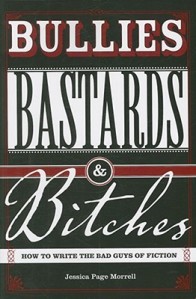::A Writer’s Reference by Jessica Page Morrell::
Crafting a memorable and truly sinister villain can be tricky. After all, don’t writers tend to “write what they know?” And I believe most people carry out their lives with good intentions. So how does a clean-cut writer channel those complex, less-than-perfect motives and evil plots without sounding like a corny, cookie-cutter movie of the week?
As a writer, I cannot deny that my normalcy meter rests just a hair’s width above “Bat-Shit-Crazy,” thus making interesting characters and situations relatively easy for me, but coming up with a believable antagonist has been challenging. I was on a pretty good path for my antagonist, but I struggled with back story and motivations. I googled articles about sociopaths, looked at psychology websites about power-loving individuals, histories of abusive or absent parents… yeah, it was a lot to take in. Not sorry I did it, but still – I was slightly overwhelmed with information.
And then I found this awesome book. Bullies, Bastards & Bad Guys is 290 pages of villainous gold. The author guides you through the many types of characters, explaining the nuances between them and giving in-depth analyses of weaknesses and psyche. The first few chapters tackle the category of protagonists (because good guys can be bad), like the “reluctant hero” and “dark hero” and many more. This unexpected look into the factors that make up a tarnished hero was invaluable. Morrell uses examples from literature and short exercises to illustrate the character-types and help you determine the appropriate traits for her story.
Next are the antagonists. Now, I was expecting a discussion on shady, dark-suited kingpins and dirty, gun-toting convicts, but there is more to consider than my narrow view. Morrell explains that an antagonist is more than bad. After all, your good guy can be bad. The antagonist is a person (or a thing) behaving in opposition to your protagonist. That’s a textbook answer, for sure, but I was not thinking about the second suitor in a love triangle, or the office gossip, or a narcissist – y’know, not the devil. I was pleasantly intrigued by the discussion, however, I was thrilled with the in-depth content about sociopaths and the like. This was, of course, why I consulted the book in the first place. Morrell offers several examples of haunted and troubled characters and a reading list for more exploration.
Following a couple of quick chapters on how to pit your good and bad guys against each other and making the story believable, Morrell delves into a fun topic: the Bitches. Bitches can play either antagonist or protagonist, but they are always beguiling rule-breakers. The trouble with writing Bitches is they can’t always follow the same rules that the Bullies and Bastards do. Women tend to be more complex than any male sociopath (I’m a woman, I can say it), and special care should be taken to write them with all their insecurities and inconsistencies.
The book ends with a fun chapter on monsters, another on keeping your villains age-appropriate, and finally, a list of questions to ask your bad guy. All good stuff. No doubt, this is a writing tool I will keep on my shelf and refer to again and again.
For more information on this title, check out:
::OR::
Buy Bullies, Bastards & Bitches on Amazon!
– sld
